Corporate Financial Management: Royal Dutch Shell Valuation Report
VerifiedAdded on 2023/01/11
|40
|7115
|87
Report
AI Summary
This project report provides a comprehensive financial valuation of Royal Dutch Shell, evaluating its performance and market position. The report begins with an executive summary and table of contents, followed by an introduction providing an overview of the company. It examines corporate governance, financial performance through ratio analysis (profitability, asset efficiency, liquidity, and capital structure), and market structure. The analysis covers the period from 2016 to 2018, highlighting key financial metrics and trends. The report also addresses the company's risk profile, optimality of capital structure choices, dividend policy, and prospects for future valuation. The second part of the report provides a literature review and application of the valuation theory. The report concludes with recommendations based on the analysis, offering insights into Royal Dutch Shell's financial health and investment potential. The report uses financial statements and annual reports to support the analysis.
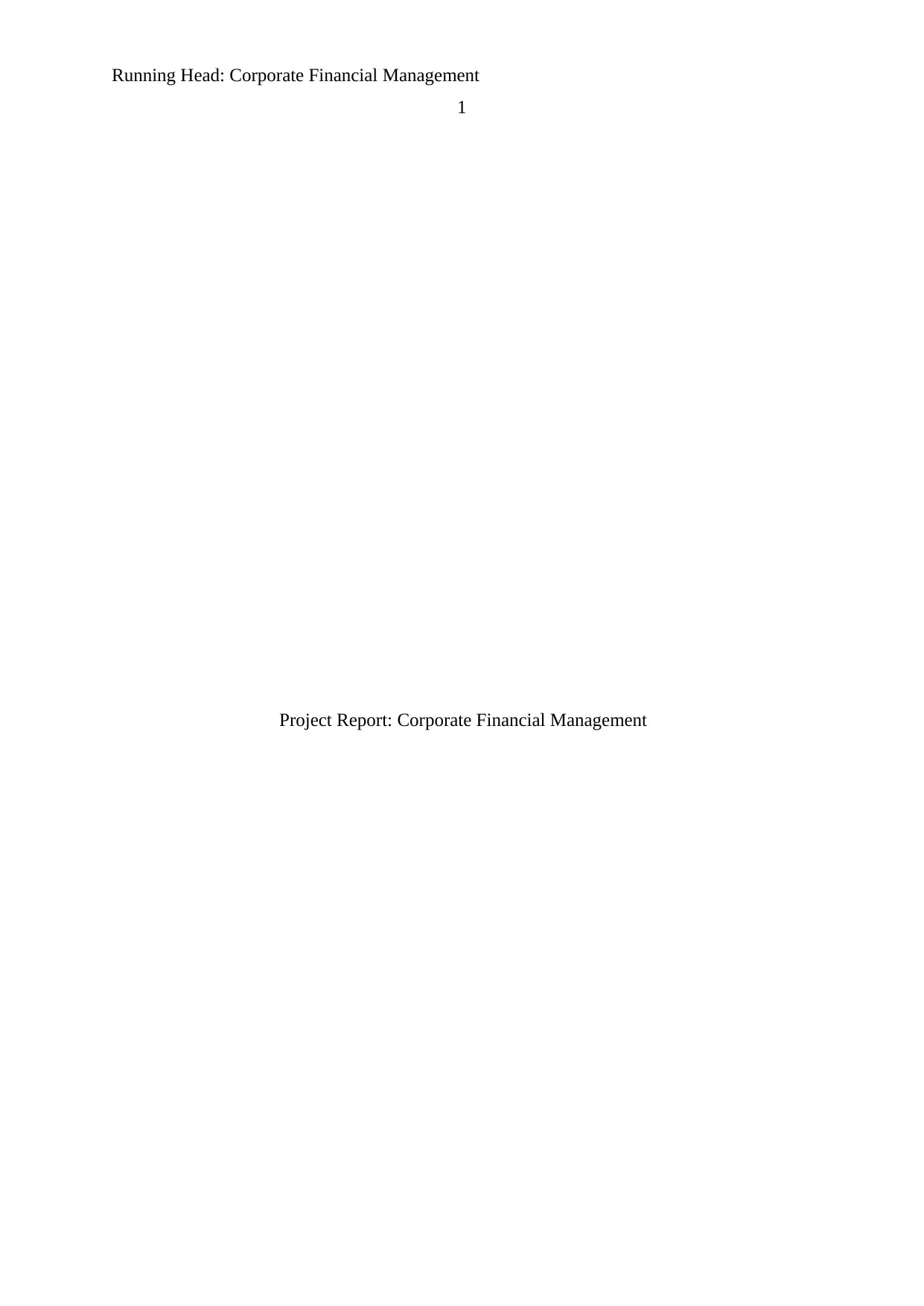
Running Head: Corporate Financial Management
1
Project Report: Corporate Financial Management
1
Project Report: Corporate Financial Management
Paraphrase This Document
Need a fresh take? Get an instant paraphrase of this document with our AI Paraphraser
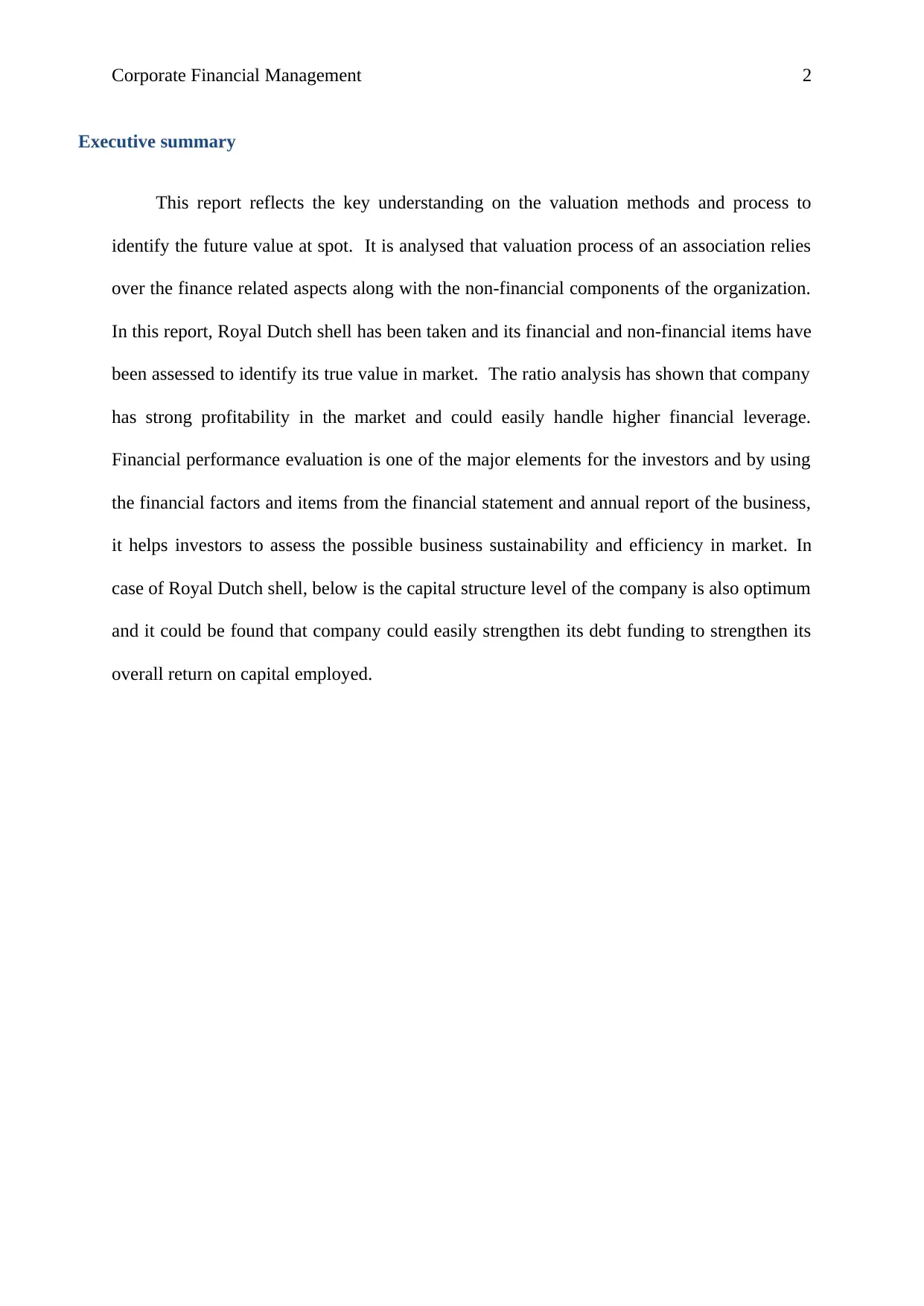
Corporate Financial Management 2
Executive summary
This report reflects the key understanding on the valuation methods and process to
identify the future value at spot. It is analysed that valuation process of an association relies
over the finance related aspects along with the non-financial components of the organization.
In this report, Royal Dutch shell has been taken and its financial and non-financial items have
been assessed to identify its true value in market. The ratio analysis has shown that company
has strong profitability in the market and could easily handle higher financial leverage.
Financial performance evaluation is one of the major elements for the investors and by using
the financial factors and items from the financial statement and annual report of the business,
it helps investors to assess the possible business sustainability and efficiency in market. In
case of Royal Dutch shell, below is the capital structure level of the company is also optimum
and it could be found that company could easily strengthen its debt funding to strengthen its
overall return on capital employed.
Executive summary
This report reflects the key understanding on the valuation methods and process to
identify the future value at spot. It is analysed that valuation process of an association relies
over the finance related aspects along with the non-financial components of the organization.
In this report, Royal Dutch shell has been taken and its financial and non-financial items have
been assessed to identify its true value in market. The ratio analysis has shown that company
has strong profitability in the market and could easily handle higher financial leverage.
Financial performance evaluation is one of the major elements for the investors and by using
the financial factors and items from the financial statement and annual report of the business,
it helps investors to assess the possible business sustainability and efficiency in market. In
case of Royal Dutch shell, below is the capital structure level of the company is also optimum
and it could be found that company could easily strengthen its debt funding to strengthen its
overall return on capital employed.
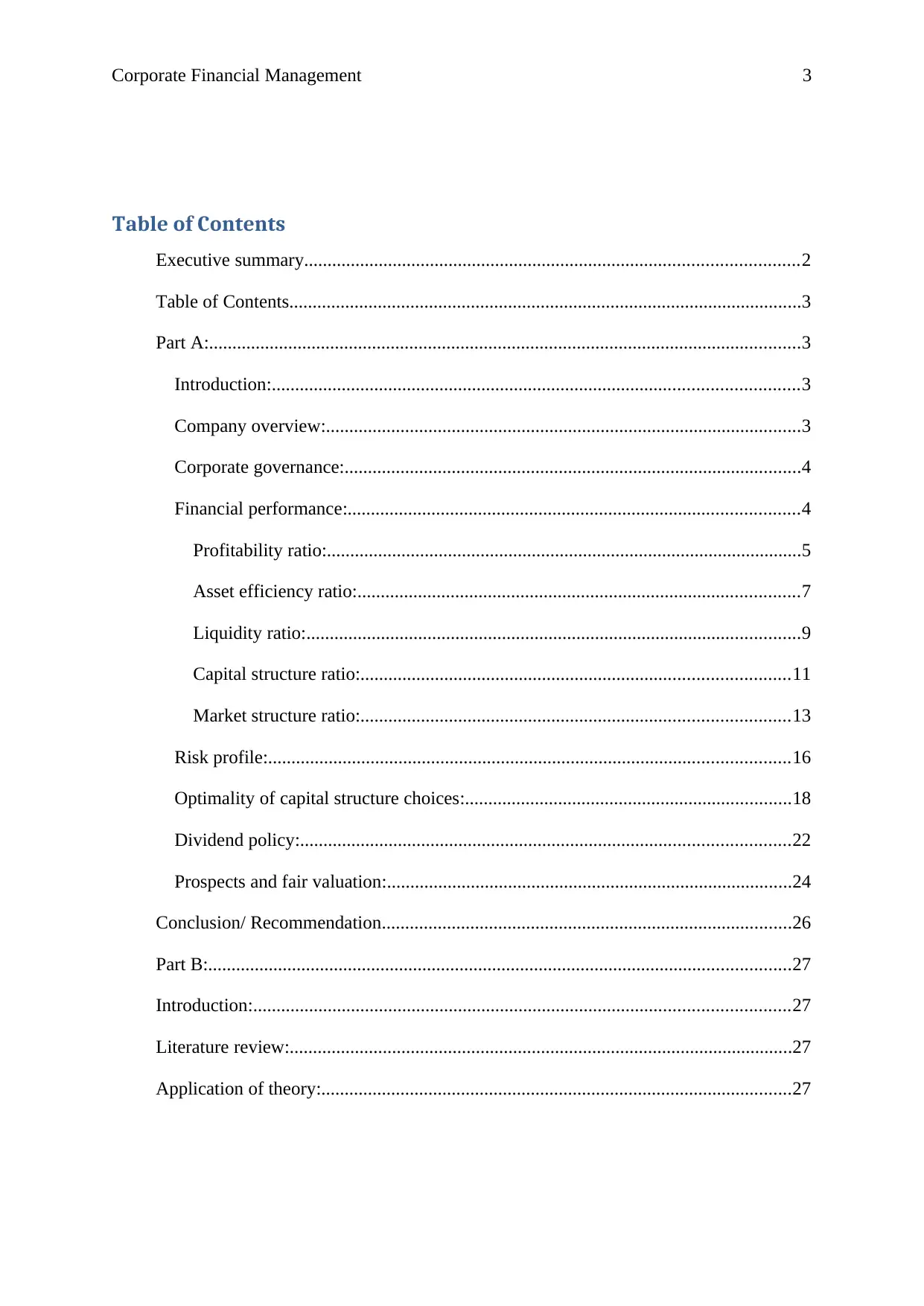
Corporate Financial Management 3
Table of Contents
Executive summary..........................................................................................................2
Table of Contents..............................................................................................................3
Part A:...............................................................................................................................3
Introduction:.................................................................................................................3
Company overview:......................................................................................................3
Corporate governance:..................................................................................................4
Financial performance:.................................................................................................4
Profitability ratio:......................................................................................................5
Asset efficiency ratio:...............................................................................................7
Liquidity ratio:..........................................................................................................9
Capital structure ratio:............................................................................................11
Market structure ratio:............................................................................................13
Risk profile:................................................................................................................16
Optimality of capital structure choices:......................................................................18
Dividend policy:.........................................................................................................22
Prospects and fair valuation:.......................................................................................24
Conclusion/ Recommendation........................................................................................26
Part B:.............................................................................................................................27
Introduction:...................................................................................................................27
Literature review:............................................................................................................27
Application of theory:.....................................................................................................27
Table of Contents
Executive summary..........................................................................................................2
Table of Contents..............................................................................................................3
Part A:...............................................................................................................................3
Introduction:.................................................................................................................3
Company overview:......................................................................................................3
Corporate governance:..................................................................................................4
Financial performance:.................................................................................................4
Profitability ratio:......................................................................................................5
Asset efficiency ratio:...............................................................................................7
Liquidity ratio:..........................................................................................................9
Capital structure ratio:............................................................................................11
Market structure ratio:............................................................................................13
Risk profile:................................................................................................................16
Optimality of capital structure choices:......................................................................18
Dividend policy:.........................................................................................................22
Prospects and fair valuation:.......................................................................................24
Conclusion/ Recommendation........................................................................................26
Part B:.............................................................................................................................27
Introduction:...................................................................................................................27
Literature review:............................................................................................................27
Application of theory:.....................................................................................................27
⊘ This is a preview!⊘
Do you want full access?
Subscribe today to unlock all pages.

Trusted by 1+ million students worldwide

Corporate Financial Management 4
Part A:
Introduction:
Valuation process of an association is a procedure wherein different components and
viewpoints are determined by the investigator, administrators and the organization’s
stakeholders to assess the presentation and the situation of the organization. There are
different factors in a corporate that has an effect over the overall performance of the
organization. Essentially, corporate administration of the organization, risk profile, capital
structure, market position, dividend factors, financial analysis and non monetary elements
have an effect over the situation of the organization.
Valuation process of an association relies over the finance related aspects along with
the non financial components of the organization (Reilly and Brown, 2011).
Company overview:
Royal Dutch shell is mainly a British company which has diversified its market into
overseas market. The company is running its business since a long time in oil and gas
industry. The market capitalization of Royal Dutch was highest in the year of 2013 in oil and
gas industry at international level. Home (2019) depicts that around 44000 service station are
owned by the company at international market. Main products consists natural gas,
petroleum, aviation fuel, oil equivalent etc. London stock exchange is the capital market of
Royal Dutch and all the dealing of stock of the company is considered by LSX. The study
explains that crisis in previous years have affected the financial performance at a bad level
but the management and strong policies of the business has helped the organization to
administer the performance again. Current marketing and non financial strategies of the
company is also strong. It helps the organization to improve the overall changes.
Part A:
Introduction:
Valuation process of an association is a procedure wherein different components and
viewpoints are determined by the investigator, administrators and the organization’s
stakeholders to assess the presentation and the situation of the organization. There are
different factors in a corporate that has an effect over the overall performance of the
organization. Essentially, corporate administration of the organization, risk profile, capital
structure, market position, dividend factors, financial analysis and non monetary elements
have an effect over the situation of the organization.
Valuation process of an association relies over the finance related aspects along with
the non financial components of the organization (Reilly and Brown, 2011).
Company overview:
Royal Dutch shell is mainly a British company which has diversified its market into
overseas market. The company is running its business since a long time in oil and gas
industry. The market capitalization of Royal Dutch was highest in the year of 2013 in oil and
gas industry at international level. Home (2019) depicts that around 44000 service station are
owned by the company at international market. Main products consists natural gas,
petroleum, aviation fuel, oil equivalent etc. London stock exchange is the capital market of
Royal Dutch and all the dealing of stock of the company is considered by LSX. The study
explains that crisis in previous years have affected the financial performance at a bad level
but the management and strong policies of the business has helped the organization to
administer the performance again. Current marketing and non financial strategies of the
company is also strong. It helps the organization to improve the overall changes.
Paraphrase This Document
Need a fresh take? Get an instant paraphrase of this document with our AI Paraphraser
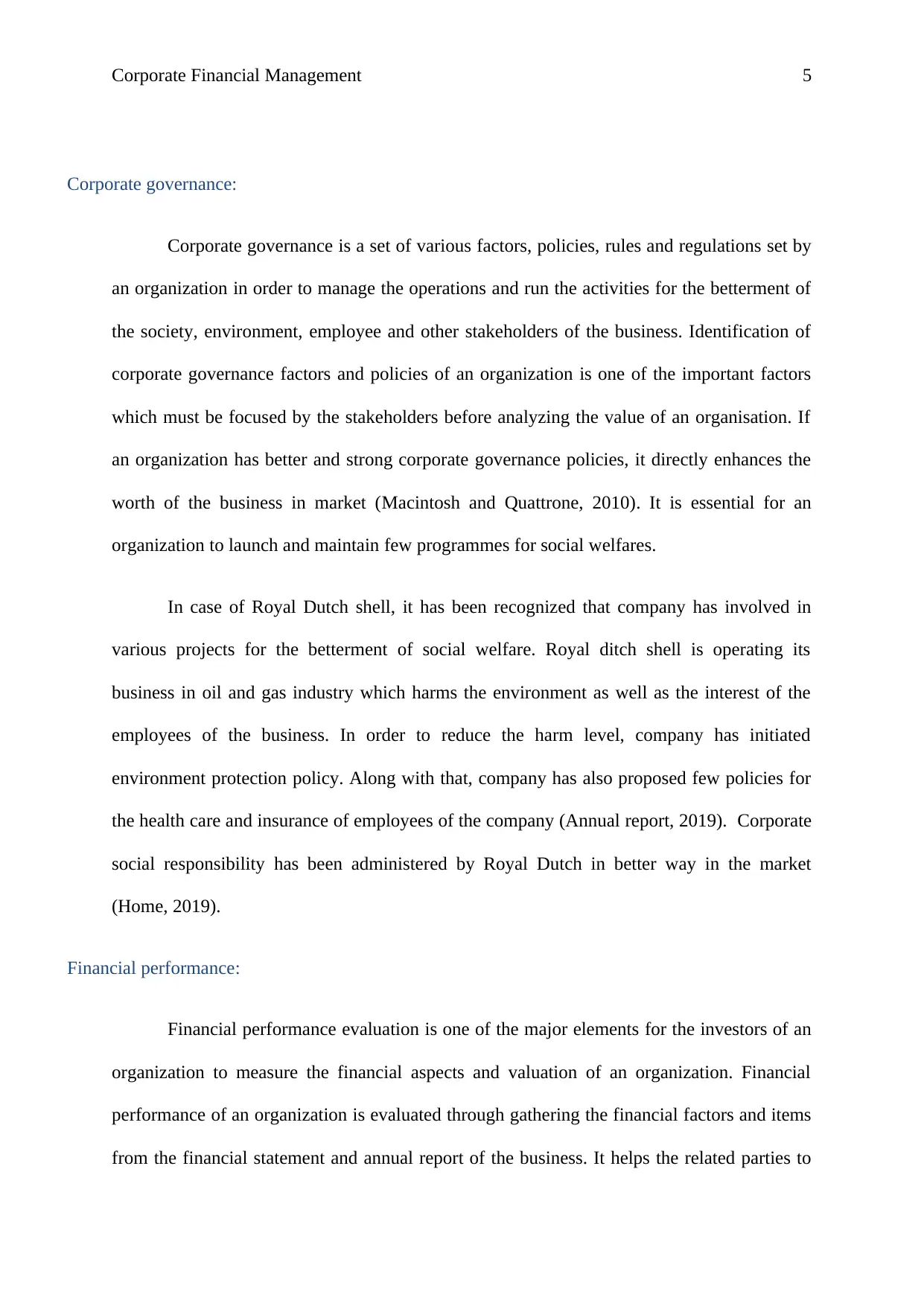
Corporate Financial Management 5
Corporate governance:
Corporate governance is a set of various factors, policies, rules and regulations set by
an organization in order to manage the operations and run the activities for the betterment of
the society, environment, employee and other stakeholders of the business. Identification of
corporate governance factors and policies of an organization is one of the important factors
which must be focused by the stakeholders before analyzing the value of an organisation. If
an organization has better and strong corporate governance policies, it directly enhances the
worth of the business in market (Macintosh and Quattrone, 2010). It is essential for an
organization to launch and maintain few programmes for social welfares.
In case of Royal Dutch shell, it has been recognized that company has involved in
various projects for the betterment of social welfare. Royal ditch shell is operating its
business in oil and gas industry which harms the environment as well as the interest of the
employees of the business. In order to reduce the harm level, company has initiated
environment protection policy. Along with that, company has also proposed few policies for
the health care and insurance of employees of the company (Annual report, 2019). Corporate
social responsibility has been administered by Royal Dutch in better way in the market
(Home, 2019).
Financial performance:
Financial performance evaluation is one of the major elements for the investors of an
organization to measure the financial aspects and valuation of an organization. Financial
performance of an organization is evaluated through gathering the financial factors and items
from the financial statement and annual report of the business. It helps the related parties to
Corporate governance:
Corporate governance is a set of various factors, policies, rules and regulations set by
an organization in order to manage the operations and run the activities for the betterment of
the society, environment, employee and other stakeholders of the business. Identification of
corporate governance factors and policies of an organization is one of the important factors
which must be focused by the stakeholders before analyzing the value of an organisation. If
an organization has better and strong corporate governance policies, it directly enhances the
worth of the business in market (Macintosh and Quattrone, 2010). It is essential for an
organization to launch and maintain few programmes for social welfares.
In case of Royal Dutch shell, it has been recognized that company has involved in
various projects for the betterment of social welfare. Royal ditch shell is operating its
business in oil and gas industry which harms the environment as well as the interest of the
employees of the business. In order to reduce the harm level, company has initiated
environment protection policy. Along with that, company has also proposed few policies for
the health care and insurance of employees of the company (Annual report, 2019). Corporate
social responsibility has been administered by Royal Dutch in better way in the market
(Home, 2019).
Financial performance:
Financial performance evaluation is one of the major elements for the investors of an
organization to measure the financial aspects and valuation of an organization. Financial
performance of an organization is evaluated through gathering the financial factors and items
from the financial statement and annual report of the business. It helps the related parties to
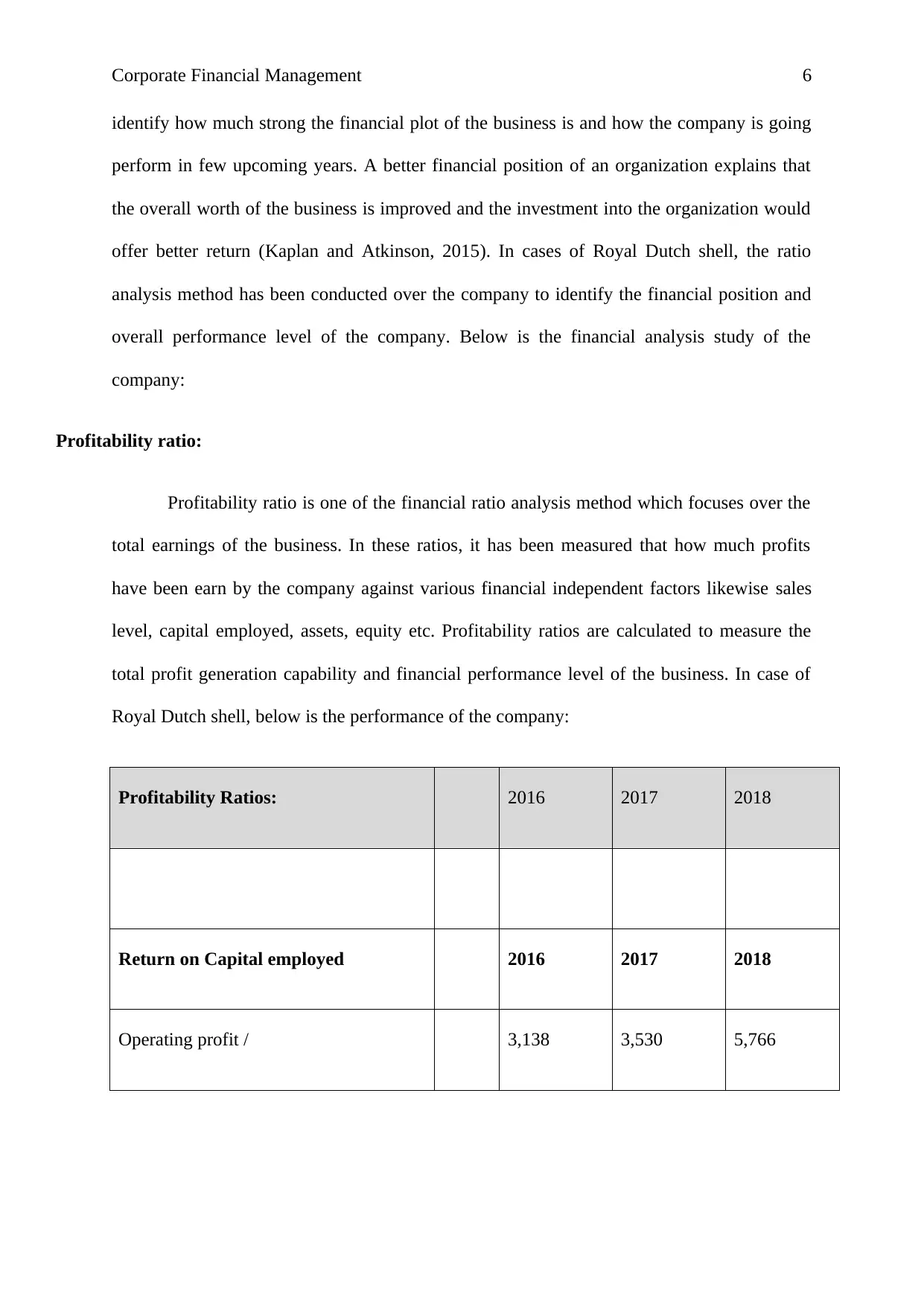
Corporate Financial Management 6
identify how much strong the financial plot of the business is and how the company is going
perform in few upcoming years. A better financial position of an organization explains that
the overall worth of the business is improved and the investment into the organization would
offer better return (Kaplan and Atkinson, 2015). In cases of Royal Dutch shell, the ratio
analysis method has been conducted over the company to identify the financial position and
overall performance level of the company. Below is the financial analysis study of the
company:
Profitability ratio:
Profitability ratio is one of the financial ratio analysis method which focuses over the
total earnings of the business. In these ratios, it has been measured that how much profits
have been earn by the company against various financial independent factors likewise sales
level, capital employed, assets, equity etc. Profitability ratios are calculated to measure the
total profit generation capability and financial performance level of the business. In case of
Royal Dutch shell, below is the performance of the company:
Profitability Ratios: 2016 2017 2018
Return on Capital employed 2016 2017 2018
Operating profit / 3,138 3,530 5,766
identify how much strong the financial plot of the business is and how the company is going
perform in few upcoming years. A better financial position of an organization explains that
the overall worth of the business is improved and the investment into the organization would
offer better return (Kaplan and Atkinson, 2015). In cases of Royal Dutch shell, the ratio
analysis method has been conducted over the company to identify the financial position and
overall performance level of the company. Below is the financial analysis study of the
company:
Profitability ratio:
Profitability ratio is one of the financial ratio analysis method which focuses over the
total earnings of the business. In these ratios, it has been measured that how much profits
have been earn by the company against various financial independent factors likewise sales
level, capital employed, assets, equity etc. Profitability ratios are calculated to measure the
total profit generation capability and financial performance level of the business. In case of
Royal Dutch shell, below is the performance of the company:
Profitability Ratios: 2016 2017 2018
Return on Capital employed 2016 2017 2018
Operating profit / 3,138 3,530 5,766
⊘ This is a preview!⊘
Do you want full access?
Subscribe today to unlock all pages.

Trusted by 1+ million students worldwide
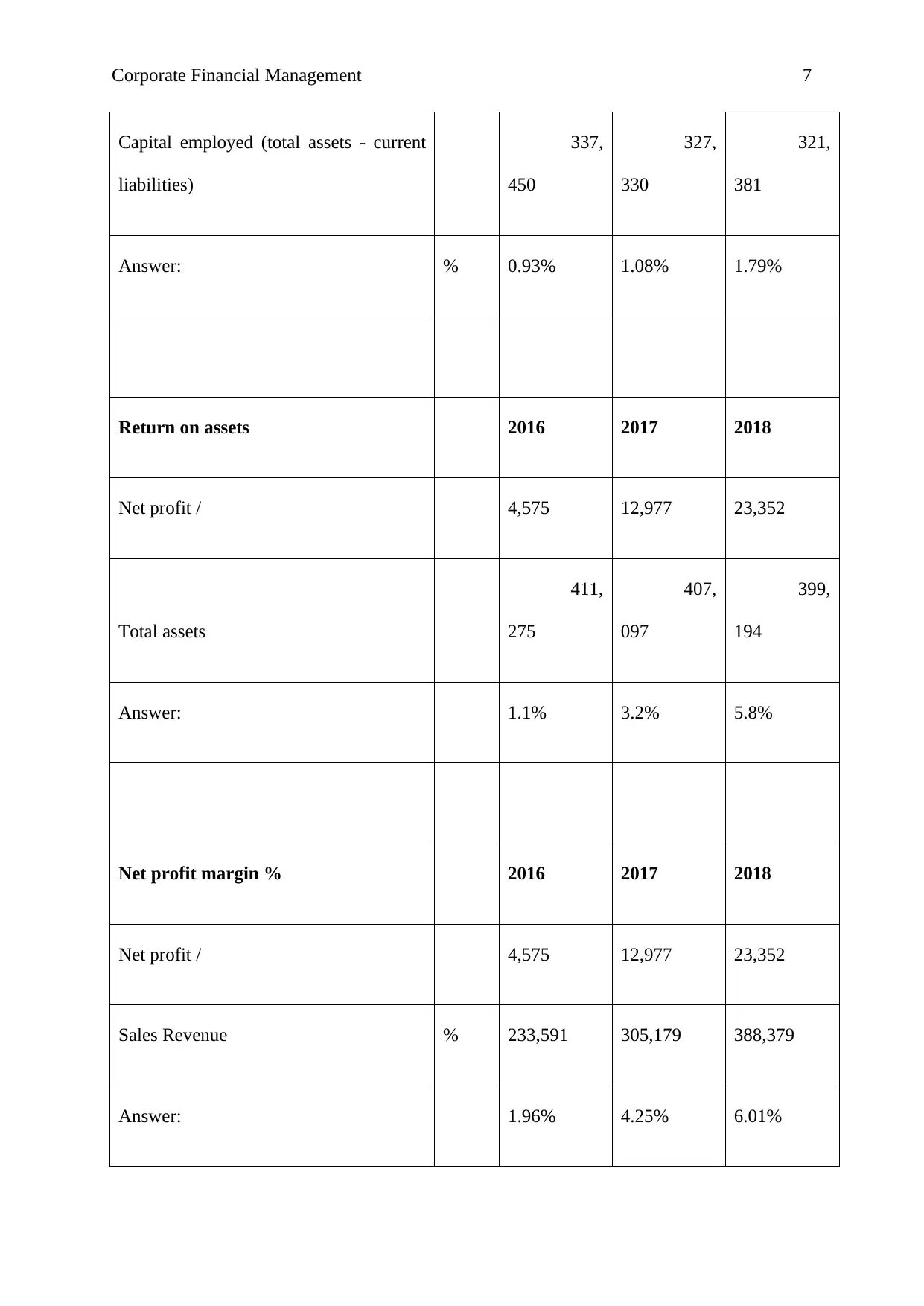
Corporate Financial Management 7
Capital employed (total assets - current
liabilities)
337,
450
327,
330
321,
381
Answer: % 0.93% 1.08% 1.79%
Return on assets 2016 2017 2018
Net profit / 4,575 12,977 23,352
Total assets
411,
275
407,
097
399,
194
Answer: 1.1% 3.2% 5.8%
Net profit margin % 2016 2017 2018
Net profit / 4,575 12,977 23,352
Sales Revenue % 233,591 305,179 388,379
Answer: 1.96% 4.25% 6.01%
Capital employed (total assets - current
liabilities)
337,
450
327,
330
321,
381
Answer: % 0.93% 1.08% 1.79%
Return on assets 2016 2017 2018
Net profit / 4,575 12,977 23,352
Total assets
411,
275
407,
097
399,
194
Answer: 1.1% 3.2% 5.8%
Net profit margin % 2016 2017 2018
Net profit / 4,575 12,977 23,352
Sales Revenue % 233,591 305,179 388,379
Answer: 1.96% 4.25% 6.01%
Paraphrase This Document
Need a fresh take? Get an instant paraphrase of this document with our AI Paraphraser
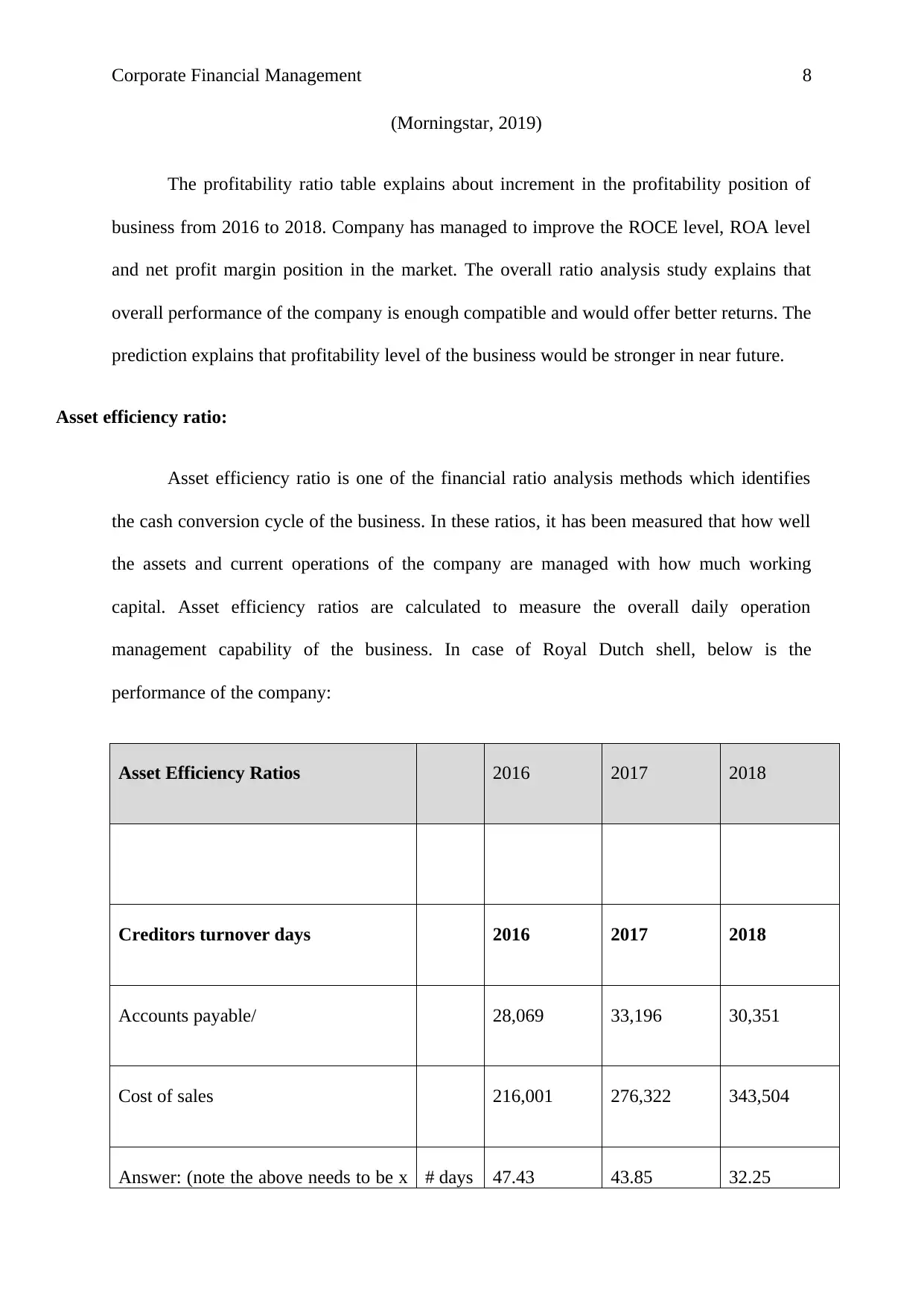
Corporate Financial Management 8
(Morningstar, 2019)
The profitability ratio table explains about increment in the profitability position of
business from 2016 to 2018. Company has managed to improve the ROCE level, ROA level
and net profit margin position in the market. The overall ratio analysis study explains that
overall performance of the company is enough compatible and would offer better returns. The
prediction explains that profitability level of the business would be stronger in near future.
Asset efficiency ratio:
Asset efficiency ratio is one of the financial ratio analysis methods which identifies
the cash conversion cycle of the business. In these ratios, it has been measured that how well
the assets and current operations of the company are managed with how much working
capital. Asset efficiency ratios are calculated to measure the overall daily operation
management capability of the business. In case of Royal Dutch shell, below is the
performance of the company:
Asset Efficiency Ratios 2016 2017 2018
Creditors turnover days 2016 2017 2018
Accounts payable/ 28,069 33,196 30,351
Cost of sales 216,001 276,322 343,504
Answer: (note the above needs to be x # days 47.43 43.85 32.25
(Morningstar, 2019)
The profitability ratio table explains about increment in the profitability position of
business from 2016 to 2018. Company has managed to improve the ROCE level, ROA level
and net profit margin position in the market. The overall ratio analysis study explains that
overall performance of the company is enough compatible and would offer better returns. The
prediction explains that profitability level of the business would be stronger in near future.
Asset efficiency ratio:
Asset efficiency ratio is one of the financial ratio analysis methods which identifies
the cash conversion cycle of the business. In these ratios, it has been measured that how well
the assets and current operations of the company are managed with how much working
capital. Asset efficiency ratios are calculated to measure the overall daily operation
management capability of the business. In case of Royal Dutch shell, below is the
performance of the company:
Asset Efficiency Ratios 2016 2017 2018
Creditors turnover days 2016 2017 2018
Accounts payable/ 28,069 33,196 30,351
Cost of sales 216,001 276,322 343,504
Answer: (note the above needs to be x # days 47.43 43.85 32.25

Corporate Financial Management 9
365)
Stock Turnover (days) 2016 2017 2018
Average Inventory / 21,775 25,223 21,117
Cost of Sales # days 216,001 276,322 343,504
Answer: (note the above needs to be x
365) 36.80 33.32 22.44
Debtors Turnover (days) 2016 2017 2018
Average trade debtors / 41,454 45,929 44,269
Sales revenue (note used operating
revenue) # days
233,5
91
305,1
79
388,3
79
Answer: (note the above needs to be x
365) 64.77 54.93 41.60
(Morningstar, 2019)
365)
Stock Turnover (days) 2016 2017 2018
Average Inventory / 21,775 25,223 21,117
Cost of Sales # days 216,001 276,322 343,504
Answer: (note the above needs to be x
365) 36.80 33.32 22.44
Debtors Turnover (days) 2016 2017 2018
Average trade debtors / 41,454 45,929 44,269
Sales revenue (note used operating
revenue) # days
233,5
91
305,1
79
388,3
79
Answer: (note the above needs to be x
365) 64.77 54.93 41.60
(Morningstar, 2019)
⊘ This is a preview!⊘
Do you want full access?
Subscribe today to unlock all pages.

Trusted by 1+ million students worldwide
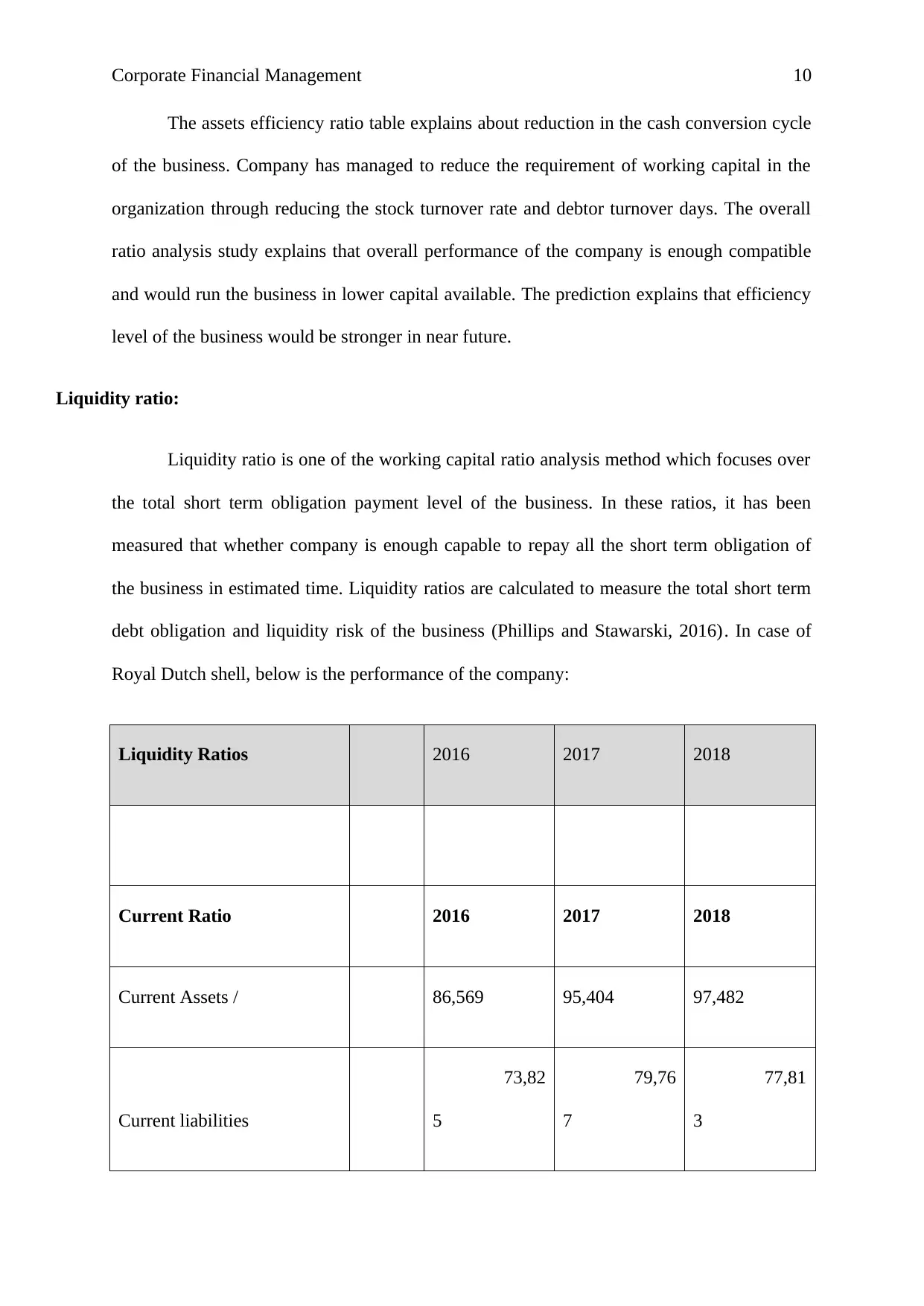
Corporate Financial Management 10
The assets efficiency ratio table explains about reduction in the cash conversion cycle
of the business. Company has managed to reduce the requirement of working capital in the
organization through reducing the stock turnover rate and debtor turnover days. The overall
ratio analysis study explains that overall performance of the company is enough compatible
and would run the business in lower capital available. The prediction explains that efficiency
level of the business would be stronger in near future.
Liquidity ratio:
Liquidity ratio is one of the working capital ratio analysis method which focuses over
the total short term obligation payment level of the business. In these ratios, it has been
measured that whether company is enough capable to repay all the short term obligation of
the business in estimated time. Liquidity ratios are calculated to measure the total short term
debt obligation and liquidity risk of the business (Phillips and Stawarski, 2016). In case of
Royal Dutch shell, below is the performance of the company:
Liquidity Ratios 2016 2017 2018
Current Ratio 2016 2017 2018
Current Assets / 86,569 95,404 97,482
Current liabilities
73,82
5
79,76
7
77,81
3
The assets efficiency ratio table explains about reduction in the cash conversion cycle
of the business. Company has managed to reduce the requirement of working capital in the
organization through reducing the stock turnover rate and debtor turnover days. The overall
ratio analysis study explains that overall performance of the company is enough compatible
and would run the business in lower capital available. The prediction explains that efficiency
level of the business would be stronger in near future.
Liquidity ratio:
Liquidity ratio is one of the working capital ratio analysis method which focuses over
the total short term obligation payment level of the business. In these ratios, it has been
measured that whether company is enough capable to repay all the short term obligation of
the business in estimated time. Liquidity ratios are calculated to measure the total short term
debt obligation and liquidity risk of the business (Phillips and Stawarski, 2016). In case of
Royal Dutch shell, below is the performance of the company:
Liquidity Ratios 2016 2017 2018
Current Ratio 2016 2017 2018
Current Assets / 86,569 95,404 97,482
Current liabilities
73,82
5
79,76
7
77,81
3
Paraphrase This Document
Need a fresh take? Get an instant paraphrase of this document with our AI Paraphraser

Corporate Financial Management 11
Answer: 1.17 1.20 1.25
Cash ratio 2016 2017 2018
(Cash + marketable
securities) / 19,130 20,312 26,741
Current Liabilities
73,82
5
79,76
7
77,81
3
Answer: 0.26 0.25 0.34
Quick ratio 2016 2017 2018
Current Assets - Inventory / 64,794 70,181 76,365
Current Liabilities
73,82
5
79,76
7
77,81
3
Answer: 0.88 0.88 0.98
(Morningstar, 2019)
Answer: 1.17 1.20 1.25
Cash ratio 2016 2017 2018
(Cash + marketable
securities) / 19,130 20,312 26,741
Current Liabilities
73,82
5
79,76
7
77,81
3
Answer: 0.26 0.25 0.34
Quick ratio 2016 2017 2018
Current Assets - Inventory / 64,794 70,181 76,365
Current Liabilities
73,82
5
79,76
7
77,81
3
Answer: 0.88 0.88 0.98
(Morningstar, 2019)
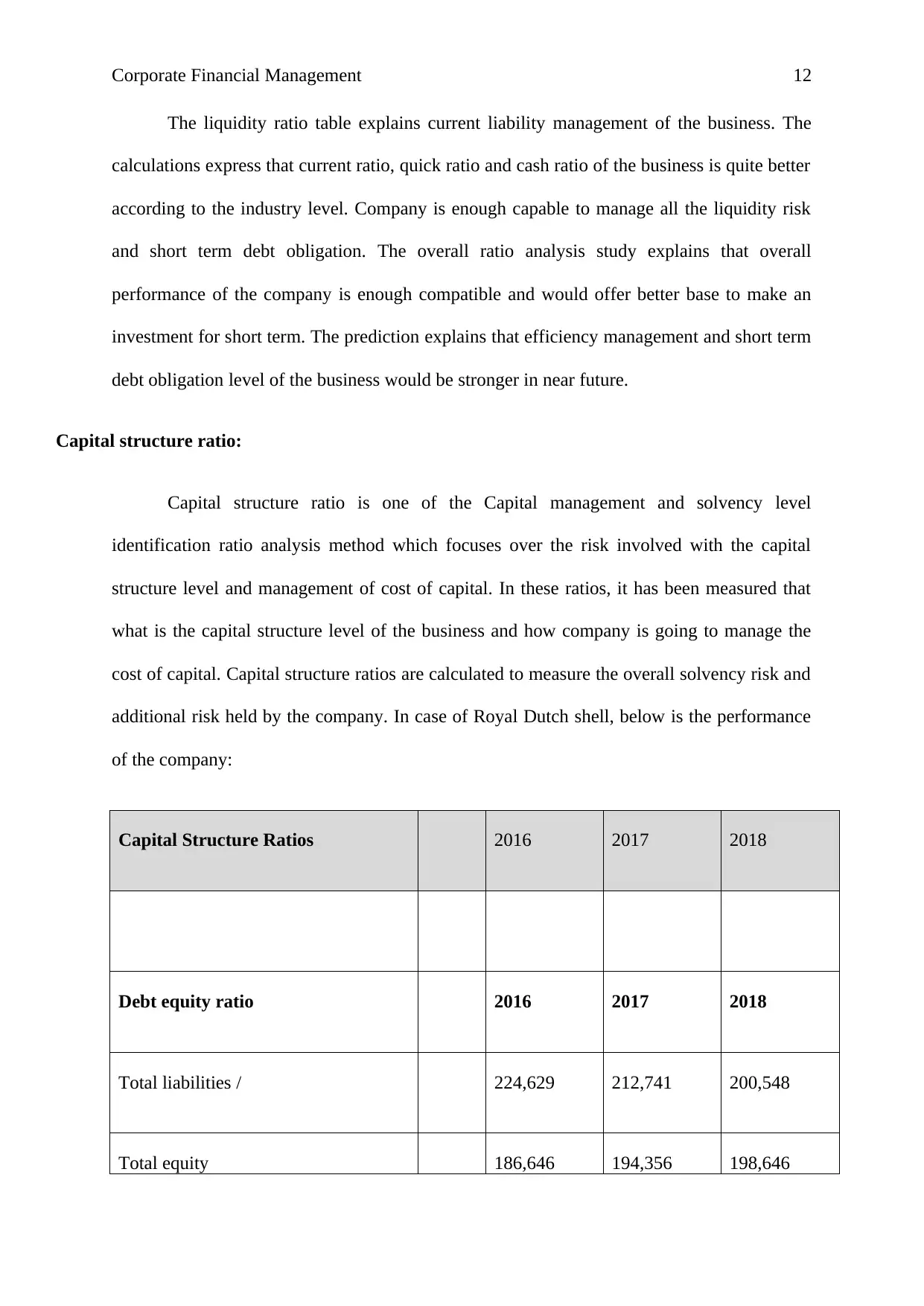
Corporate Financial Management 12
The liquidity ratio table explains current liability management of the business. The
calculations express that current ratio, quick ratio and cash ratio of the business is quite better
according to the industry level. Company is enough capable to manage all the liquidity risk
and short term debt obligation. The overall ratio analysis study explains that overall
performance of the company is enough compatible and would offer better base to make an
investment for short term. The prediction explains that efficiency management and short term
debt obligation level of the business would be stronger in near future.
Capital structure ratio:
Capital structure ratio is one of the Capital management and solvency level
identification ratio analysis method which focuses over the risk involved with the capital
structure level and management of cost of capital. In these ratios, it has been measured that
what is the capital structure level of the business and how company is going to manage the
cost of capital. Capital structure ratios are calculated to measure the overall solvency risk and
additional risk held by the company. In case of Royal Dutch shell, below is the performance
of the company:
Capital Structure Ratios 2016 2017 2018
Debt equity ratio 2016 2017 2018
Total liabilities / 224,629 212,741 200,548
Total equity 186,646 194,356 198,646
The liquidity ratio table explains current liability management of the business. The
calculations express that current ratio, quick ratio and cash ratio of the business is quite better
according to the industry level. Company is enough capable to manage all the liquidity risk
and short term debt obligation. The overall ratio analysis study explains that overall
performance of the company is enough compatible and would offer better base to make an
investment for short term. The prediction explains that efficiency management and short term
debt obligation level of the business would be stronger in near future.
Capital structure ratio:
Capital structure ratio is one of the Capital management and solvency level
identification ratio analysis method which focuses over the risk involved with the capital
structure level and management of cost of capital. In these ratios, it has been measured that
what is the capital structure level of the business and how company is going to manage the
cost of capital. Capital structure ratios are calculated to measure the overall solvency risk and
additional risk held by the company. In case of Royal Dutch shell, below is the performance
of the company:
Capital Structure Ratios 2016 2017 2018
Debt equity ratio 2016 2017 2018
Total liabilities / 224,629 212,741 200,548
Total equity 186,646 194,356 198,646
⊘ This is a preview!⊘
Do you want full access?
Subscribe today to unlock all pages.

Trusted by 1+ million students worldwide
1 out of 40
Related Documents
Your All-in-One AI-Powered Toolkit for Academic Success.
+13062052269
info@desklib.com
Available 24*7 on WhatsApp / Email
![[object Object]](/_next/static/media/star-bottom.7253800d.svg)
Unlock your academic potential
Copyright © 2020–2025 A2Z Services. All Rights Reserved. Developed and managed by ZUCOL.



